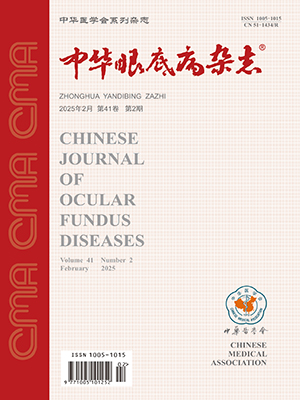| 1. |
Valencia-Sanchez C, Wingerchuk DM. Emerging targeted therapies for neuromyelitis optica spectrum disorders[J]. BioDrugs, 2021, 35(1): 7-17. DOI: 10.1007/s40259-020-00460-9.
|
| 2. |
Lin CW, Lin IH, Chen TC, et al. Clinical course and treatment response of neuromyelitis optica spectrum disease: an 8-year experience[J]. Asia Pac J Ophthalmol (Phila), 2019, 8(3): 206-210. DOI: 10.22608/apo.2018247.
|
| 3. |
Kang H, Chen T, Li H, et al. Prognostic factors and disease course in aquaporin-4 antibody-positive Chinese patients with acute optic neuritis[J]. J Neurol, 2017, 264(10): 2130-2140. DOI: 10.1007/s00415-017-8606-9.
|
| 4. |
Wingerchuk DM, Banwell B, Bennett JL, et al. International consensus diagnostic criteria for neuromyelitis optica spectrum disorders[J]. Neurology, 2015, 85(2): 177-189. DOI: 10.1212/wnl.0000000000001729.
|
| 5. |
Xie L, Zhou H, Song H, et al. Comparative analysis of immunosuppressive therapies for myelin oligodendrocyte glycoprotein antibody-associated optic neuritis: a cohort study[J/OL]. Br J Ophthalmol, 2021, 2021: bjophthalmol-2020-318769 (2021-04-30)[2021-11-03]. https://bjo.bmj.com/content/early/2021/04/29/bjophthalmol-2020-318769.long. DOI: 10.1136/bjophthalmol-2020-318769. [published online ahead of print].
|
| 6. |
Storoni M, Davagnanam I, Radon M, et al. Distinguishing optic neuritis in neuromyelitis optica spectrum disease from multiple sclerosis: a novel magnetic resonance imaging scoring system[J]. J Neuroophthalmol, 2013, 33(2): 123-127. DOI: 10.1097/WNO.0b013e318283c3ed.
|
| 7. |
中华医学会眼科学分会神经眼科学组, 兰州大学循证医学中心/世界卫生组织指南实施与知识转化合作中心. 中国脱髓鞘性视神经炎诊断和治疗循证指南(2021年)[J]. 中华眼科杂志, 2021, 3(57): 171-186. DOI: 10.3760/cma.j.issn.0412-4081.2019.03.017.Neuro-ophthalmology Group of Ophthalmology Branch of Chinese Medical Association, Evidence-based Medicine Center of Lanzhou University/World Health Organization Collaborating Centre for Guideline Implementation and Knowledge Translation. Evidence-based guidelines for diagnosis and treatment of demyelinating optic neuritis in China (2021)[J]. Chin J Ophthalmol, 2021, 3(57): 171-186. DOI: 10.3760/cma.j.issn.0412-4081.2019.03.017.
|
| 8. |
Li H, Wang Y, Xu Q, et al. Features of anti-aquaporin 4 antibody-seropositive Chinese patients with neuromyelitis optica spectrum optic neuritis[J]. J Neurol, 2015, 262(10): 2293-2304. DOI: 10.1007/s00415-015-7844-y.
|
| 9. |
Matiello M, Lennon VA, Jacob A, et al. NMO-IgG predicts the outcome of recurrent optic neuritis[J]. Neurology, 2008, 70(23): 2197-2200. DOI: 10.1212/01.wnl.0000303817.82134.da.
|
| 10. |
Gospe SM 3rd, Chen JJ, Bhatti MT. Neuromyelitis optica spectrum disorder and myelin oligodendrocyte glycoprotein associated disorder-optic neuritis: a comprehensive review of diagnosis and treatment[J]. Eye (Lond), 2021, 35(3): 753-768. DOI: 10.1038/s41433-020-01334-8.
|
| 11. |
Bonnan M, Valentino R, Debeugny S, et al. Short delay to initiate plasma exchange is the strongest predictor of outcome in severe attacks of NMO spectrum disorders[J]. J Neurol Neurosurg Psychiatry, 2018, 89(4): 346-351. DOI: 10.1136/jnnp-2017-316286.
|
| 12. |
De Lott LB, Burke JF, Andrews CA, et al. Association of individual-level factors with visual outcomes in optic neuritis: secondary analysis of a randomized clinical trial[J/OL]. JAMA Netw Open, 2020, 3(5): e204339. [2020-05-01]. https://pubmed.ncbi.nlm.nih.gov/32379333/. DOI: 10.1001/jamanetworkopen.2020.4339.
|
| 13. |
Merle H, Olindo S, Bonnan M, et al. Natural history of the visual impairment of relapsing neuromyelitis optica[J]. Ophthalmology, 2007, 114(4): 810-815. DOI: 10.1016/j.ophtha.2006.06.060.
|
| 14. |
Zhou H, Zhao S, Yin D, et al. Optic neuritis: a 5-year follow-up study of Chinese patients based on aquaporin-4 antibody status and ages[J]. J Neurol, 2016, 263(7): 1382-1389. DOI: 10.1007/s00415-016-8155-7.
|
| 15. |
Gao C, Zhuo Z, Duan Y, et al. Structural and functional alterations in visual pathway after optic neuritis in MOG antibody disease: a comparative study with AQP4 seropositive NMOSD[J/OL]. Front Neurol, 2021, 12: 673472[2021-06-09]. https://pubmed.ncbi.nlm.nih.gov/34177778/. DOI: 10.3389/fneur.2021.673472.
|
| 16. |
Zhang L, Zhuang Y, Liu X, et al. The efficacy of therapeutic apheresis in patients with refractory neuromyelitis optica spectrum disorders: a single-center retrospective study[J]. Ann Palliat Med, 2021, 10(3): 3105-3114. DOI: 10.21037/apm-21-177.
|
| 17. |
Papais-Alvarenga RM, Miranda-Santos CM, Puccioni-Sohler M, et al. Optic neuromyelitis syndrome in Brazilian patients[J]. J Neurol Neurosurg Psychiatry, 2002, 73(4): 429-435. DOI: 10.1136/jnnp.73.4.429.
|




